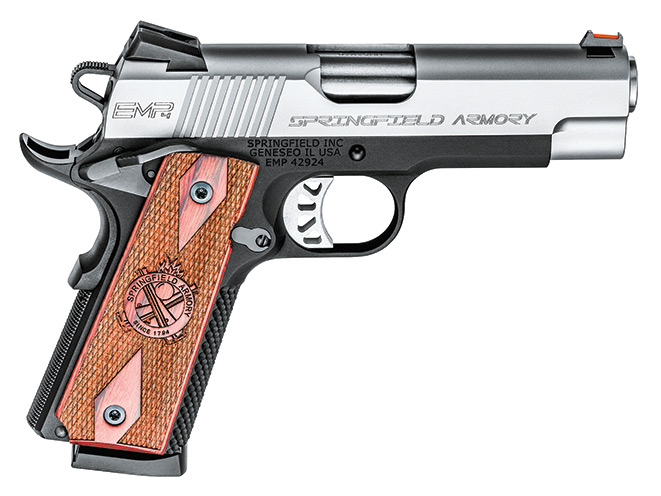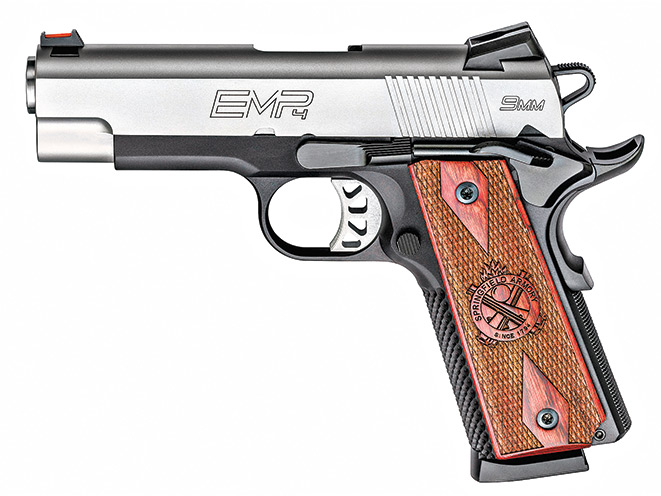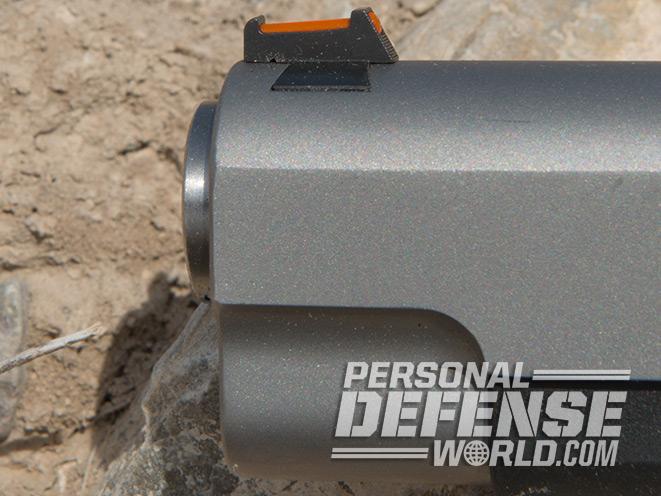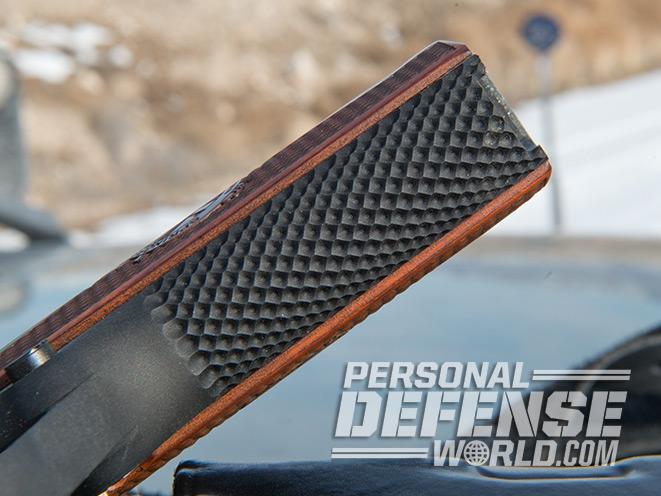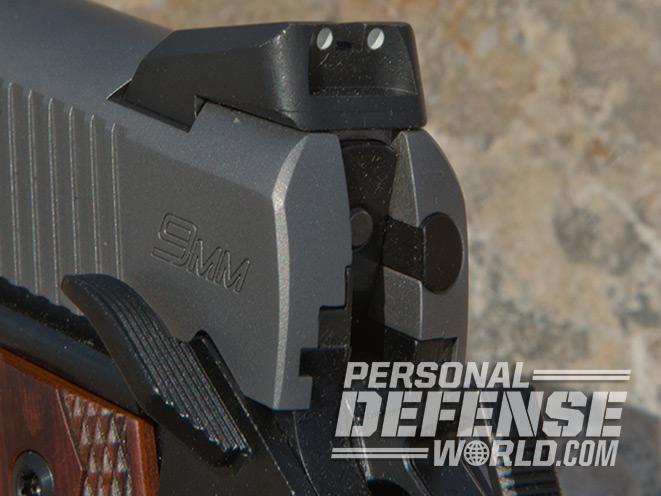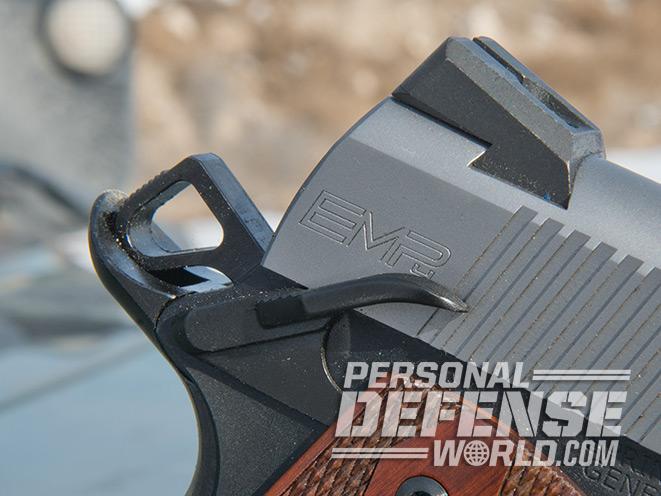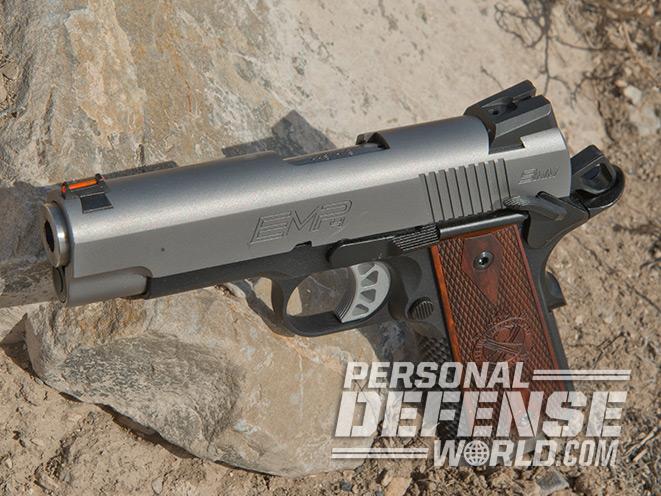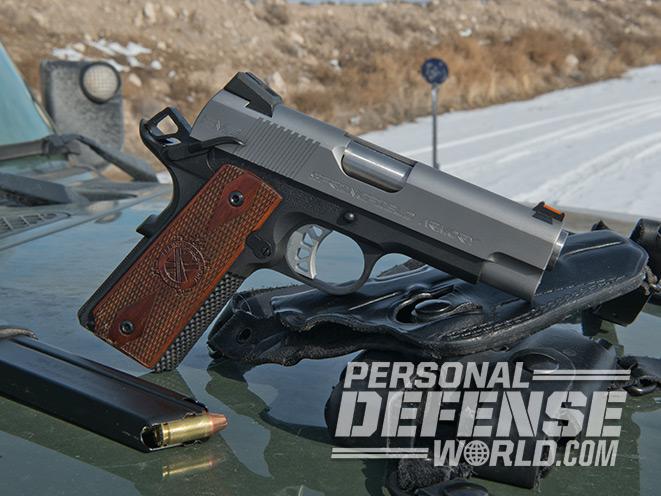Springfield Armory’s EMP pistols have become favorites for many concealed carriers. A good friend of mine carries his 9mm EMP constantly. It’s lightweight, accurate and “always works.” I have used the EMP in both 9mm and .40 S&W, but I’m just not a huge fan of 3-inch-barreled pistols for primary carry. Although it’s not uncommon for me to carry a full-sized 1911 or the latest high-capacity polymer pistol, I’ve found 4-inch-barreled pistols are about perfect for me and remain reliable, easy to conceal and lightweight.
Many of my carry pistols are chambered in .45 ACP or even .50 GI, but the 9mm chambering has been catching my eye of late. I appreciate the lower recoil and find that the reliability of modern 9mm ammo is improving. It has been used in 1911s for years, though not with great frequency. Designed for the .45 ACP case length, it requires different magazines, and they can be finicky. Slide speed with light bullets can also be problematic. Since the EMP was designed from the ground up to run the 9mm, it seemed the perfect candidate for a longer barrel, and the Springfield Armory EMP 4″ Lightweight Champion is the end result.
Enhanced Micro
Advertisement — Continue Reading Below

Recognizing the value of a small 1911 pistol chambered in 9mm, Springfield Armory built the EMP in 2007. The chamber system was shortened and the gun’s remaining dimensions balanced to fit. Standard EMP actions are 0.125 inches shorter than typical 1911s. On the original EMP, an aluminum frame kept the gun light while maintaining a 9+1 capacity. Low-profile, tritium combat sights are used along with a match-grade, bull barrel. The new EMP 4” Lightweight Champion starts there and adds a few improvements with some differences.
The frame remains aluminum and includes frontstrap dimpling. It’s not overly aggressive, but it does ensure a solid hold. The grip length has also been increased, allowing for a new 10-round magazine. These mags are stainless steel with a steel follower and coated in black satin. The grip is cut moderately high and holds an extended grip safety. Slightly rounding the bottom of the checkered mainspring housing also lessens the chance of printing during concealment, while flaring the mag well assists with magazine changes.
The gun’s ambidextrous safety is slim to enhance concealed carry. Grooves on the slide stop and magazine release keep things working in adverse conditions. An aluminum trigger offers a crisp reset, limited take-up and no overtravel. All in all, sharp edges are kept to a minimum on this EMP.
Advertisement — Continue Reading Below
A forged stainless steel slide includes rear cocking serrations and a satin finish. It houses a 4-inch, stainless steel, match-grade fully supported and ramped barrel. The full-length guide rod uses a flat spring and reverse plug typical of bull barrels. The EMP features a fiber-optic front sight with a low profile rear with white dots. Its grips are made from cocobolo and include the Springfield Armory logo. The gun shipped in a hard case with three 10-round magazines, a holster, a magazine pouch, some extra fiber-optic rods and a takedown tool for the guide rod.
Gearing Up
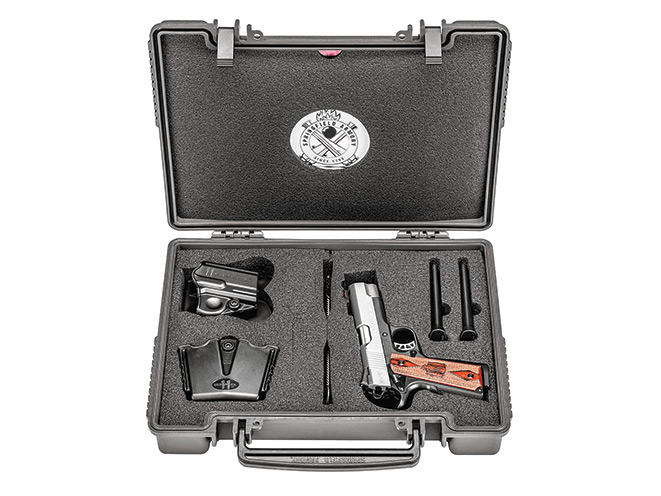
Advertisement — Continue Reading Below
Recent training with a .45 ACP pistol brought to my attention a need for a 9mm pistol with a 4-inch barrel. Both my 9mm 1911 pistols are all steel and full size, so something designed for everyday carry was preferred. The EMP uses a 4-inch barrel, making it shorter than a standard Commander (4.25 inches), and its overall length remains shorter than other 4-inch-barreled 1911s by 0.20 inches. It handles and points like any other 1911. It also fits into all my non-railed 1911 holsters without issue.
Most of my testing was completed using my Milt Sparks Nexus IWB holster and Alessi Bodyguard shoulder rig. When my back is doing well, the Nexus is my primary carry holster. It has held a dozen different 1911 pistols over the last couple years. When mated to a good belt, it is as comfortable as IWB carry gets. For travel, or when my back is acting up, the Alessi steps in. Moving the weight to my shoulders is comfortable for me, and a good shoulder rig is excellent when driving. I’ve used this rig for years to carry a number of full-sized 1911 pistols.
Initial testing consisted of just enough range time to ensure proper operation with some Barnes 115-grain TAC-XP ammunition. After 100 rounds, it never missed a beat and was POA/POI at 15 yards, which is about perfect. It carried great in most any 1911 holster I used, though my magazine pouches are a different story. Some of my old and worn leather magazine pouches were pretty loose, though my newer ones worked fine. After moving to Kydex magazine pouches, I found it to be about the same. For duty or strenuous operations, you will want to ensure a tighter fit. There are plenty of purpose-built magazine carriers for the EMP, so you should consider those to be your best choice. Until you round them up, a well-built leather pouch or adjustable Kydex 1911 pouch will work. The added length of the 10-round magazine meant they fit perfectly in the Alessi Bodyguard.
Advertisement — Continue Reading Below
Carried over several days in both rigs, the EMP performed as expected, which is to say very well. It fits snug to the body in the IWB holster and was all but unnoticed in the shoulder rig. At 31 ounces, it is heavier than the standard EMP and about the same as an aluminum-framed 1911 of similar size. It’s about as comfortable to carry as a 1911 gets.
Range Time

Given my travel schedule, most of it in my truck, I decided to get some vehicle training in. When not on the range or in the office, I am traveling between them. Traveling to media and training events comprises the rest of my time, so much is spent behind the wheel of my truck.
Advertisement — Continue Reading Below
Working from both sides of the vehicle, the EMP was brought to bear on steel and cardboard placed at various points around the truck. Using the Nexus holster, it was pretty easy to get on target while shooting through the window, it just requires you take the time to work out the seatbelt placement. It’s also a good idea to practice with gloves, hats, jackets or anything you may wear given the climate. Take things slow, working out how best to not cover yourself or anyone else in the truck. Make certain you start buckled up and work out how best to get that belt off and on target.
The EMP was easy to maneuver and operated without incident shooting around the mirror with the door open. My training positions were less than pristine, but there was no issue when operating the gun with a less than perfect grip. When using both off- and strong-hand grips on the gun, it worked perfectly. I experienced the same reliability during one-handed shooting. The EMP ejected brass confidently, with no strays bouncing off my head.
Using my shoulder rig with the EMP required a bit more thought. Shoulder holsters are comfortable for sure, just not always conducive to the safest gun handling. Especially within the confines of a vehicle you need to be careful not to cover your side, thigh or other body part. On the other hand, they are easy to get to. The EMP fit nicely in the holster and released properly and quickly. Magazine changes are not fast by any means but can be worked out. Make sure you can reach them with your off hand for standard reloads. It’s also a good idea to practice off-hand reloads using your strong hand to access the magazines (if they are on the right side). All testing using the shoulder rig was uneventful, with no malfunctions.
Advertisement — Continue Reading Below
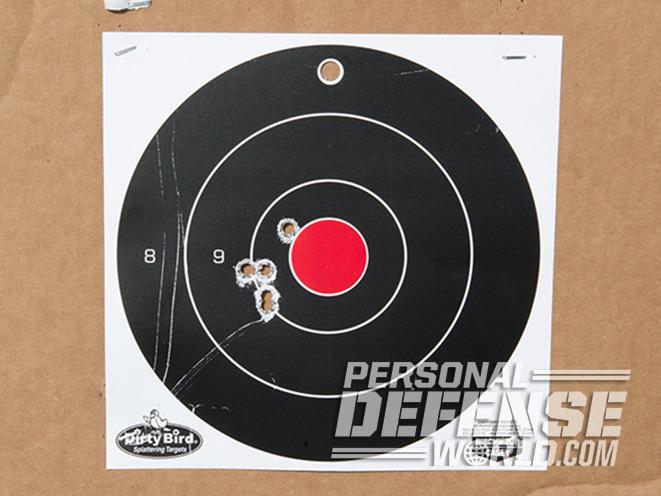
Accuracy with the EMP 4” was excellent, with my best group at 25 yards measuring just over 1.25 inches using the Barnes 115-grain TAC-XPD. Barnes’ TAC-XPD is soft shooting and proves accurate in most anything I use it in. It’s my go-to round for compacts, while the DoubleTap load that uses the same bullet goes in my larger 9mm pistols. While the EMP Lightweight Champion is a “compact” pistol by description, it is basically a Commander-sized pistol with the same barrel length as many duty guns. When shooting at 10 yards and in, it cut one ever-larger hole. It is easy to control, locks in the hand and is as accurate as any pistol not purposely designed for target work.
Springfield Armory’s EMP 4” Lightweight Champion is ready out of the box for concealed carry, off-duty use or even plainclothes operations. Any changes would be personal. My large hands prefer normal grips, which is an easy change. Fiber-optic sights are popular, just not my preferred setup, but the EMP uses Novak sight cuts, so swapping them out is easy. I ordered a Trijicon HD front and Heinie rear for this pistol just in case it sticks around.
Advertisement — Continue Reading Below
Final Shots
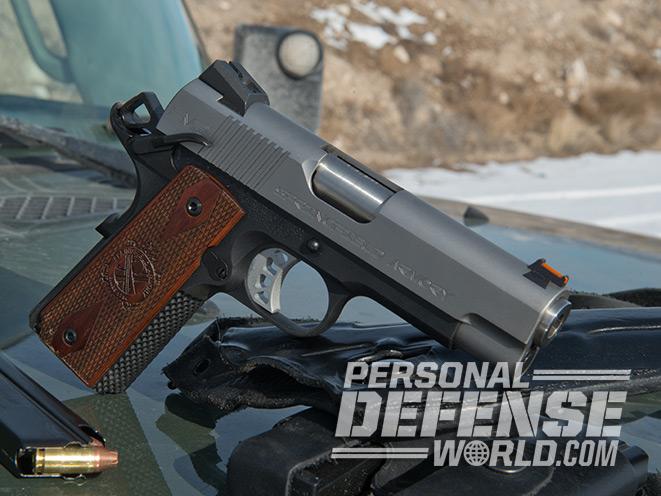
My test pistol never missed a beat. There were no malfunctions, and since it may stay with me, it was run pretty hard. Several hundred rounds of rapid-fire drills using all types of ammunition did not cause an issue. It’s accurate and lightweight with a nicely checkered frontstrap. The trigger is crisp and predictable, and having 10+ rounds of 9mm is a nice bonus. This gun really is about perfect for concealed carry if you’re using a 1911-style pistol. If you are in the market for a 4- or 4.25-inch-barreled 1911 in 9mm, make sure you give the EMP Lightweight Champion a very close look.
Advertisement — Continue Reading Below
For more, visit http://www.springfield-armory.com or call 800-680-6866.
